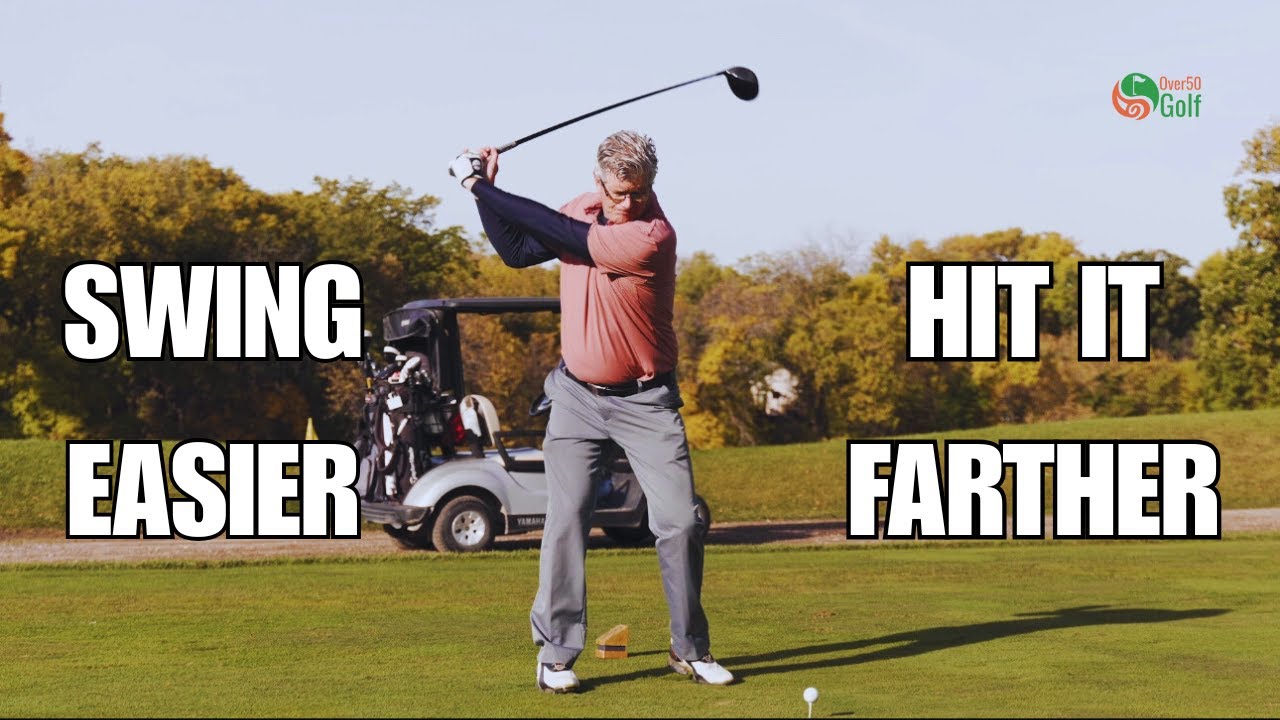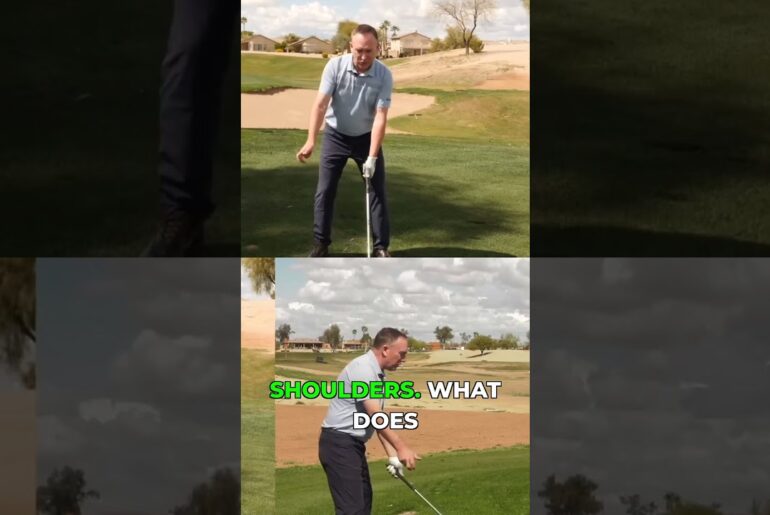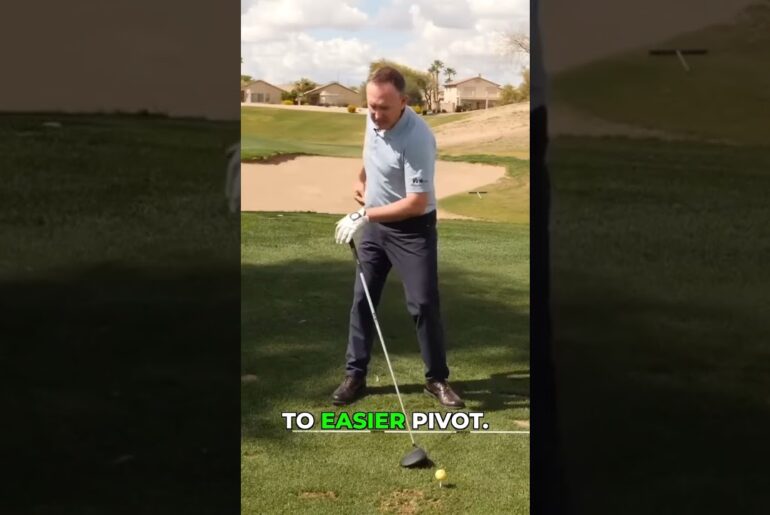Most golfers over 50 lose distance trying to swing harder — but tension kills speed. In this video, Barry Gibson, PGA of Canada Golf Professional, shows how to hit it longer, swing easier, and play more consistent golf by using simple body-friendly adjustments that fit the 50+ golfer.
You’ll learn:
✅ Why swinging harder actually slows your swing down
✅ How to create effortless power with a smooth tempo
✅ Three key adjustments to unlock distance and consistency
✅ Simple ways to build a golf swing that works with your body, not against it
If you’re ready to improve your golf swing, move better, and play pain-free — we offer Golf Lessons in Winnipeg and online golf coaching for golfers everywhere.
📞 Book your FREE Swing & Mobility Consultation today and get a personalized video swing analysis from Over50 Golf.
👉 https://www.over50golf.com/book-a-consultation
Chapters
00:00 Intro
01:10 Why Swinging Harder Doesn’t Work
02:28 Take The Tension Out
04:24 The Right Tension
05:49 Prime Your Swing – Do The Golf Dance!
08:06 Adjustment #1 – Let Your Head Move
09:45 Adjustment #2 – Pick Up Your Heel
11:31 Adjustment #3 – Wide Takeaway
13:44 Put It All together
🏌️♂️ Learn more about our programs:
Stop Slicing Forever – https://over50golf.samcart.com/products/fix-your-slice-for-good
Golf Swing Basics – https://shop.over50golf.com/products/golf-swing-basics
Yoga for the Over 50 Golfer – https://over50golf.samcart.com/products/yoga-over-50-golfer
Fascia Release for Golfers – https://over50golf.samcart.com/products/fascia-fitness-for-golfers-101
📚 Check out our book “Your Best Golf Begins After 50 – Make the Back Nine Your Best Nine.”
https://shop.over50golf.com/products/your-best-golf-begins-after-50-golf-book
#GolfLessonsWinnipeg #Over50Golf #SeniorGolf #GolfTips #GolfInstruction #GolfCoaching #GolfSwing #MobilityForGolfers #EffortlessPower #GolfOver50
Hey, Barry here from Over 50 Golf. In today’s lesson, we’re going to talk about putting some distance back in your game and how swinging easier can actually help you hit it farther. Yes, swinging easier. What’s the natural reaction as you start to lose distance? Well, some people go out and buy new clubs and then they find out the new clubs are like the old clubs, but then they go off and start swinging harder. I’m going to force the swing. I’m going to muscle it. You know, I’m not swinging hard enough and I’m going to try to hit harder. Or they get into swinging those speed sticks. And what happens? You work harder. You get less out of it. In fact, you might even injure yourself. So, I’m going to show you how swinging easier can help you swing the club faster and more effectively. Before we get started, just a little bit of housekeeping. If you like this channel, you like our content, please subscribe, and we that helps us to grow our community of golfers, and we really love hearing from our community. If there’s any tips or lessons you want to see for your game, shoot us a message, put it in the comments, and we’ll be happy to include it in our series. So, let’s get started. So, I want to talk about why swinging harder doesn’t work for the over 50 golfer. So, as we get older, we tend to lose a little bit of mobility. You know, we don’t turn and pivot as well as we used to. Back swing maybe starts to get a little bit shorter. Change of direction gets a little bit rushed and we’re just not moving as well as we used to. And then when we try to hit the ball harder, you know, generally what happens is golfers will tense up too much and they’re trying to they end up trying to force the swing and that even disrupts the swing even more. The swing even gets a little bit shorter because you’re putting so much extra tension into the body. Change of direction starts to break down. You know, the whole swing sequence starts to fall apart and the whole timing gets disrupted and so they end up working harder and swinging slower and it becomes more frustrating. What we want to do is we want to put the flow back into the swing. We want to put some rhythm back in the swing and we want to take the tension out of the swing so that we can move a little bit more freer and have a little bit more rhythmical pattern of motion and swing easier. So, it’s easier on your body. You know what it’s like when you’re trying to swing too hard. You know, it it takes a lot of effort and then you increase your chances for injury. And yes, it’s it’s important as we get older to maintain our mobility, but it’s also important to understand the golf swing, too. so that we can swing a little bit more efficiently. So, I’m going to show you some simple adjustments you can incorporate into your swing to help your swing become a lot more efficient. You can have a better swing sequence and move more efficiently to generate easy speed, which is what we want. The first thing we want to do is take the tension out. Now, I’m not talking about being loosey goosey in that. You know, we do need some live muscle tension so that we can move the golf club effectively and control the club face for solid contact. But when we swing too hard, golfers won’t tense up too much. you know, they stand over the ball, they’re squeezing that club too tight, shoulders and upper body get super tight and stiff, and then they get this kind of slashing motion at it where they’re trying to propel their arms as fast as possible, and the body doesn’t have time to react. The body doesn’t have time to turn and pivot. And it’s important that the arms and body work together. The swing flows this way from the ground up with the body turning and pivoting and then putting the speed out to the golf club to strike the golf ball. And there’s an efficient way to do that. When you put too much tension into your body, disrupts that, disrupts your pivot, disrupts your turn, destroys the whole action of the golf swing. One thing to look at is with good players is they, yes, they swing very efficiently and they have good timing because they allow that to happen in the golf swing. When golfers try to swing too hard, their swings get a little bit shorter and then they flash down into the ball. They tend to muscle it with their upper body and arms too quickly. And we see this sort of action where they’re really turning and lunging at it and trying to hit it with a very short swing and not much of a pivot. Better players, longer hitters, they’ll have more of a flowing action. Yes, their swings might look fairly fast, but they have a good rotation going back, good timing starting down, and then wham, they hit it. You know, how often you’ve seen those players, they swing the golf club, and you go like, “Well, this hardly hardly looks like they’re working.” And boom, that ball’s just flying off forever. Well, they’re creating some efficient speed. And it isn’t about swinging hard. So, first we want to work a little bit on taking the tension out and creating a little bit more efficiency in your swing. Now, when we watch good players, they’re always kind of moving when they swing. You know, they they come into the shot, they grab the club, they they do a little bit of waggle, step, do a bit of a shuffle, maybe a forward press, and then they go. Many golfers don’t do that. They come in, they stand stand static over it. They’re not really focused on the target that much. They got all kinds of swing thoughts going on. And they’re trying to, oh, focus on that golf ball. You know, I haven’t been hitting the ball very well. It’s all over the club face, so I’m going to keep my head still here. And oh, I don’t want they try to swing. So, you’re you’re already priming yourself to swing inefficiently. Instead, we want to prime ourselves to move more rhythmically and flowing with that good sequence of motion for good, efficient speed. So, one way to do that is just pick up your driver, hold it up in front of you. I want you to squeeze it as tight as you can and then just let it go and let your arms relax. And then find that middle point for this nice lively tension. Enough muscle tension to free up your motion and enough to be able to control the golf club. So, it’s not super tight. It’s not super loose. we need to have enough tension in there to allow us to move and to control the golf club. So, that’s just one good way to kind of feel that. And then the next we’re going to do a little bit of an exercise to kind of put a little bit more rhythm into your swing so you can understand the action of the golf swing. Just going to take your stance, hold the club up in front of you, and we’re just going to do a little half swing motion back and forth. But I don’t want you to keep your lower body still. You notice I’m letting my right heel come up and then my left heel come up. Right heel up, left heel up. And we’re kind of doing a little bit of golf of a golf stance here. Back and forth. Heel up, heel up, heel down, heel up. So I’m kind of doing a little dancing action here. Back and forth. And I’m using that rhythmical dancing action back and forth to move the golf club. It’s unforced. Right back through back and through. And you notice as I’m doing that, there’s a definite sequence and cadence to it. So, I’m going to start. I’m going to go forward. A little bit of a forward press. I turn toward the target. I let my heel come up. To swing the club back, heel goes down. Club swings back. I let my left heel come up. Heel goes down. let my body swing through. So, we’re getting this rhythmical cadence from the ground up to help me move the golf club. You can add a little stutter step into it if you want, back and forth, but that stepping action precedes the turn. So, forward, back, down, forward. The step happens before the turn. So, this little golf swing dance here back and forth helps to free the swing up, get the tension out of the swing, and give you that nice free swinging action and through. You can just hear that club whipping. It’s easy speed. It’s not forced. So, that’s a great practice drill to do to help as a warm-up. You can do it on the range. You can do it at home. Help take the tension out of the swing and help with that flow in the swing. So, now let’s get into some of those swing adjustments. So, three simple adjustments I want you to incorporate into your swing to help you move a little bit better and help you create a little bit more efficient speed. You know, the first thing is don’t fixate on the ball and try to keep your head too still. Now, we see golfers do this where they set up and they’re got their head down and they’re focusing on that golf ball, you know, because they I’ve been hitting it, not hitting it very good, and someone told me to keep my head still, so I’m going to keep my head still. problem was when I keep my head still, you know, I tense up my neck and shoulders and I shorten up my swing. I I can’t turn and pivot. Your swing gets a little bit more like like that. That’s a lot of work. I’m working pretty hard with my upper body and I’m not getting anything out of it. We want more of a flowing action, a natural turn. So, what we see with good players often when they’re swinging, their head swivels a little bit. So, don’t be afraid to let that head swivel back and forth. That frees up the trunk. That allows you to turn a lot more freely, especially as we’re getting older and we’re losing some mobility in the upper chest and that thoracic spine. Allowing that head and neck to swivel frees you up to finish your back swing. In fact, some of the longest hitters, Jack Nicholas in his prime used to kind of his head to the right to allow for a fuller turn to allow that body so he could complete the back swing and then swing back. You know, yes, you don’t have to have the big high hands like Jack Nicholas and all that. That’s fantastic if you can do that. Remember again, it’s not the length of the swing. It’s about being able to turn. So, when you’re swinging back, don’t be afraid to let your head swivel a little bit, right? Let it free up. That’s going to allow you to rotate back to finish your back swing. The next adjustment I want you to do is let your left heel pick up. Let your front heel come up off the ground. We see that with a lot of golfers where they rotate back. They let that lead foot come up. And what does that allow you to do? Well, it allows you to turn and pivot a lot more freely to finish the back swing, which is important. We want to be able to load into the back foot, finish the back swing so that we can have that proper sequence on the down swing. If my swing is short and quick going back and I don’t finish my turn, what’s going to happen? You’re going to flash back into it with your arms and hands. You’re not giving your body a chance to generate some speed. Sure, you’re swinging hard with your arms and hands, but you’re not getting any speed. Especially as we get older, we tighten up in the hips and lower back. That’s only normal. You know, we we can’t swing back and restrict the hips and try to make that complete back swing position. You know what? That that’s really really hard on the body and I wouldn’t recommend that for anybody. So, when you’re swinging back, you want to feel that little bit easier, fuller back swing. As you go back and you’re winding up, don’t be afraid to let that heel come up. Don’t be afraid to let that lead lead knee come in. Don’t be afraid to let your pelvis turn a little bit more. That allows you to finish your back swing, which makes it easier to start down properly and release the club through the golf ball. We don’t want to lock ourselves up through here. So, when you’re swinging, just let that heel come up. It goes down, you turn through. Remember, it gets back to that golf dance drill where it’s heel to heel, back and forth. We’re freeing up the body to move and hatch back and through. takes the stress off the lower back too and the hips, you know. So, if you’re really tight through here, let that heel come up to finish your back swing. And then the last adjustment we want to make is the takeaway. I see this a lot with older golfers, especially as they get tightened up through here. When they take that club back, club goes in like this. Look what’s happening. My right elbow is going in behind me. No chest turn going on. Now it’s going like this, right? Gets pulled in here and it’s up here and it’s really a short tight back swing, right? There’s no width in the swing or like this and oh, I’m turning lots, but my arms are wrapped around my body. So now I’m going to flash at it with my arms to hit the ball and you’re not giving your body a chance to move to create that nice natural speed through the ball. So when we’re taking that club back, be a little bit wider. Feel it go back a little bit straighter. Don’t worry about pulling it inside. You know, we don’t need the club to go inside. We want it to go straighter back. So, this way you can get yourself turning naturally for you and you can have a a fuller back swing for you. And you can get this trail arm away from your body. So, you’re going to have nice hand path reach here. Your arms are going to be away from your body and you can swing a little bit more naturally. Again, gives you an easier, fuller back swing without forcing it. And that gives you potential to create more speed and to have that great sequence to start down. So one way to work on that, you can take a tee or a ball. I’ll just grab a little foam ball here and you can put it oh 10 12 in behind the club head and just work on pushing that away. That was a favorite tip for from Jack Nicholas and Mickey Wright and they were two legends and they were great drivers of the golf balls with big full back swings that that proper takeaway going back more one piece keeps the club face in line but it gets the body turning freely and naturally for you so you can make that good full wind up. And Jack Nicholas often talked about when he was trying to hit the ball the farthest he could, slower back swing with an even wider takeaway to allow himself time to finish the back swing and then start down into the golf ball with that good transition to the lead foot and just release that golf club. So, putting it all together, I’m going to not worry about keeping my head still. I’m going to let my head swivel as I go back. I’m going to free up my pelvis to allow me to finish my trunk turn, my shoulder turn. So, I’m going to let that left heel come up naturally as I wind up. And I’m going to have a good wide takeaway to kind of program that turn and finish that back swing so that I can start down into the ball and create that easy speed. Boom. The ball rockets off the club face. Lots of speed with minimal effort. Everything kind of working together, not forcing it. Just like that. And if you want more help with your game, follow the link in the comments to book a consultation and I’ll be happy to talk about how we can help you with your golf game. Keep playing golf. Keep having fun.







